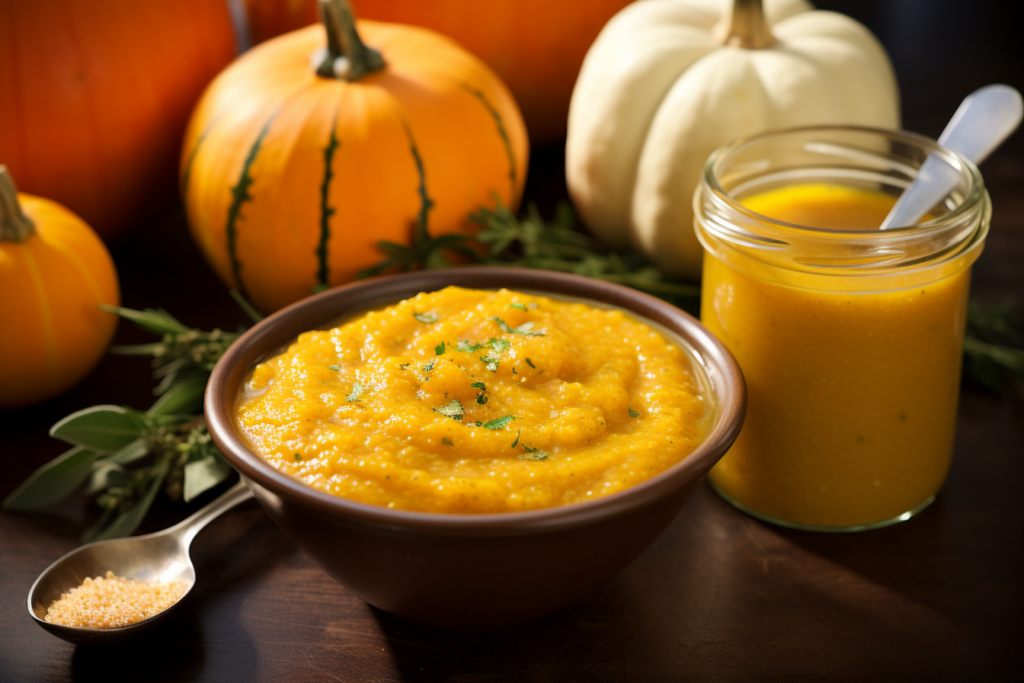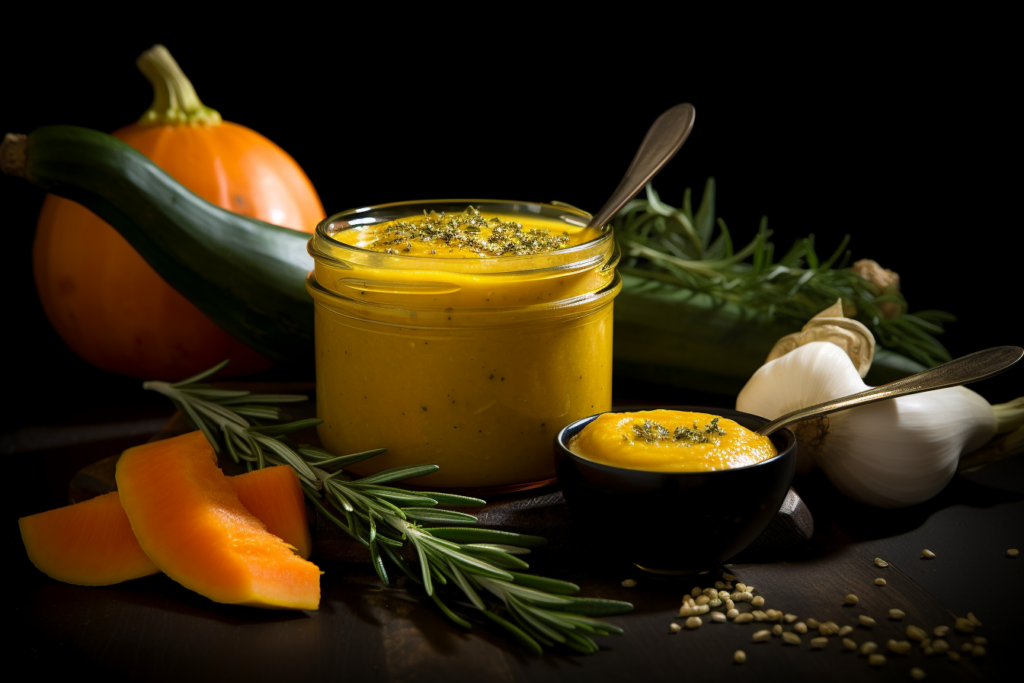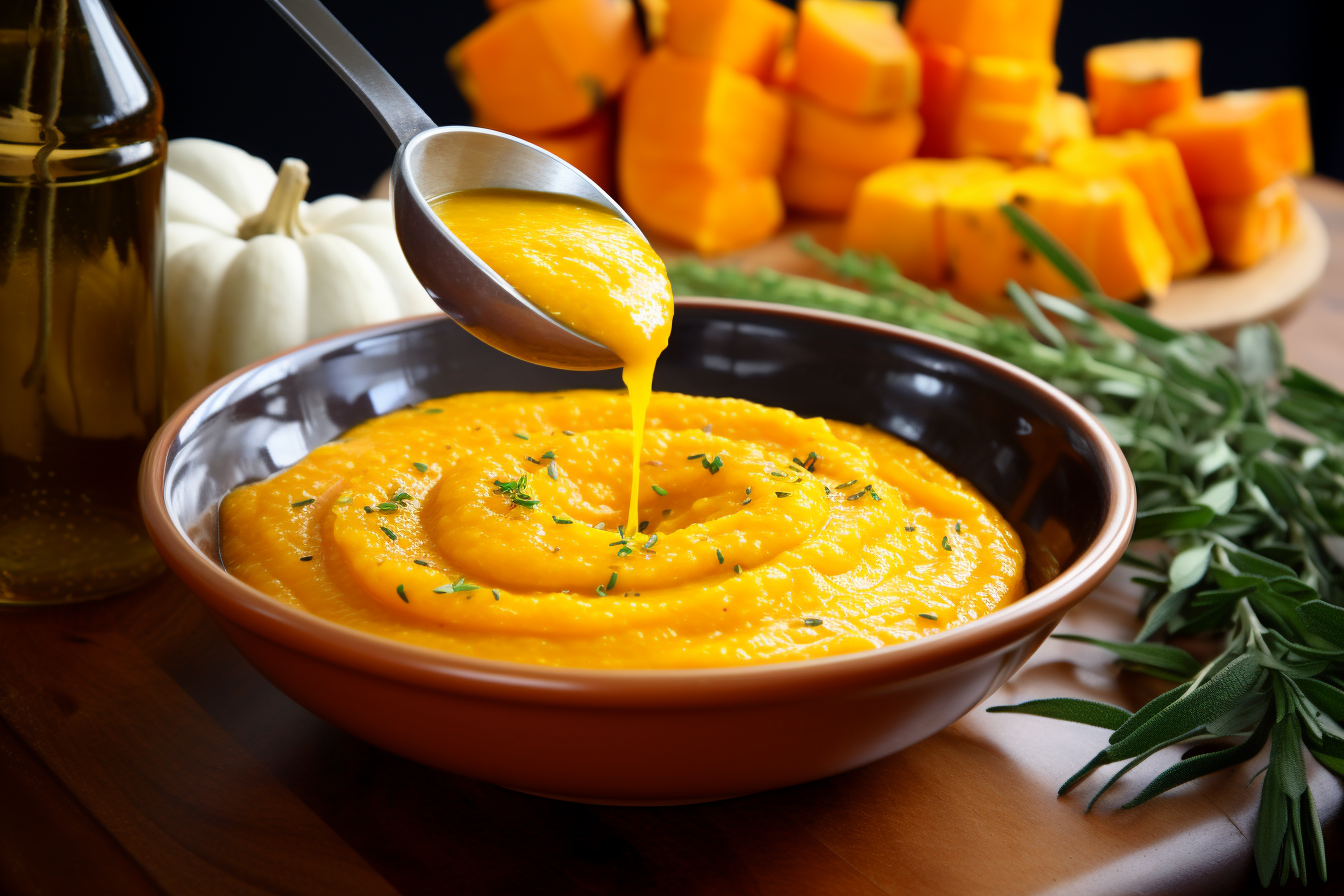In the heart of autumn’s bounty, my Squash Dressing recipe brings forth a symphony of flavors that dance on the palate, capturing the essence of the season. Picture a golden-hued elixir, crafted from the finest harvest of butternut and acorn squash, their natural sweetness elevated by a touch of maple glaze. This dressing is not merely a condiment; it’s an ode to the earth’s abundance and the warmth of the kitchen during cooler days.
The journey begins with the roasting of the squash, imparting a deep, caramelized richness to the dish. As the aromas fill the kitchen, the anticipation builds for the ensemble of complementary ingredients that join this culinary overture. Fragrant herbs, earthy sage, and a whisper of garlic weave together seamlessly, creating a tapestry of flavors that elevate the humble squash to a gourmet sensation. The final touch, a drizzle of olive oil and a splash of apple cider vinegar, adds a harmonious balance, ensuring each spoonful is a culinary crescendo.
Whether gracing the Thanksgiving table or accompanying a simple weeknight salad, this squash dressing transcends the boundaries of ordinary condiments. It’s a celebration of autumn’s bounty, a testament to the artistry of seasonal cooking, and a journey into the heart of comfort and flavor.
So, gather your ingredients, embrace the warmth of the kitchen, and let this squash dressing become the star of your fall culinary repertoire.
What is Squash Dressing?
Squash Dressing is a delectable mixture featuring the rich, sweet flavors of winter squashes such as butternut or acorn. Typically used as a condiment or accompaniment, this dressing boasts a blend of roasted or pureed squash, aromatic herbs like sage, thyme, and garlic, harmonized with olive oil and occasionally sweeteners like maple syrup.
Its versatility shines as a topping for salads, a sauce for roasted vegetables, or a unique twist on traditional stuffing. The essence lies in capturing the earthy sweetness of the squash while elevating it with a symphony of complementary flavors. Whether gracing the Thanksgiving table or enhancing everyday meals, squash dressing, much like the Mayonnaise Dressing, offers a delightful culinary journey, celebrating the bounty of autumn and the artistry of seasonal cooking.
Understanding Winter Squash
Winter Squash encompasses a group of mature squash varieties harvested in the fall, distinguished by their hard, thick rinds and seeds. These include popular types like butternut squash, acorn squash, spaghetti squash, kabocha, and pumpkin. Renowned for their sweet, nutty flavors and dense, firm flesh, winter squash is a versatile culinary ingredient.
Its applications range from soups and stews to roasted vegetable dishes, and it often stars in festive recipes, such as Thanksgiving pumpkin pie. Not only celebrated for its taste, winter squash is prized for its nutritional richness, offering vitamins, minerals, and dietary fiber. As a staple of autumn and winter cuisine, winter squash adds warmth and flavor to a variety of dishes while providing a nutritious boost to seasonal menus.
Winter Squash Varieties
Winter Squash Varieties come in a diverse range of shapes, sizes, and flavors. Here are some popular winter squash varieties:
- Butternut Squash: Known for its sweet, nutty taste and creamy texture, it’s often used in soups, purees, and roasted dishes.
- Acorn Squash: Named for its acorn-like shape, it has a mild, slightly sweet flavor. It’s commonly baked or roasted.
- Spaghetti Squash: When cooked, the flesh of this squash can be separated into strands resembling spaghetti. It has a mild flavor and is often used as a low-carb alternative to pasta.
- Kabocha Squash: Also known as Japanese pumpkin, it has a sweet, dense flesh. It’s excellent for roasting, baking, or steaming.
- Delicata Squash: With thin, edible skin and sweet, creamy flesh, delicata squash is often roasted, and its small size makes it easy to prepare.
- Hubbard Squash: These large, bumpy-skinned squashes come in various colors and have a sweet, fine-grained flesh. They’re suitable for roasting and baking.
- Buttercup Squash: Similar to kabocha, buttercup squash has a sweet and moist flesh. It’s often used in baking and roasting.
- Sugar Pumpkin: Smaller and sweeter than carving pumpkins, sugar pumpkins are commonly used in making pumpkin puree for pies and other baked goods.
- Turban Squash: Recognizable by its unique shape and vibrant colors, turban squash has a mild, sweet flavor and can be used in various dishes.
- Acorn Delight Squash: A hybrid variety with the sweet flavor of acorn squash and the creamy texture of butternut.
These winter squash varieties are not only flavorful but also nutritious, providing a good source of vitamins, minerals, and fiber. Their versatility makes them excellent additions to a variety of dishes, especially during the colder months.
Overview: How to make Squash Dressing?

Immerse yourself in the delectable symphony of flavors with this squash dressing recipe that captures the essence of autumn.
Begin by roasting butternut and acorn squash until their natural sweetness intensifies, creating a rich, caramelized base. Combine this velvety squash blend with aromatic sage, thyme, and a touch of garlic for depth and complexity. The harmonious marriage of herbs imparts a fragrant warmth, elevating the dressing to a gourmet level. A drizzle of extra-virgin olive oil and a splash of apple cider vinegar balance the sweetness with a subtle tang, enhancing the overall taste profile.
This squash dressing is a versatile delight, capable of transforming a simple Spring Salad into a culinary masterpiece or adding a burst of flavor to Roasted Vegetables. Whether gracing your Thanksgiving table or bringing warmth to a casual dinner, this dressing is a celebration of seasonal ingredients and the comforting hues of fall.
With each spoonful, savor the melding of earthy squash notes, herbal undertones, and the satisfying richness that defines this autumn-inspired dressing. It’s not just a condiment; it’s a journey into the heart of cozy, flavorful indulgence.
Easy Squash Dressing Recipe
Equipment
- Baking Dish
- Parchment Paper
- Chef's Knife
- Cutting Board
- Food Processor or Blender
- Measuring Spoons and Cups
- Oven and Oven Mitts
- Spatula
- Small Bowl
- Garlic Press
- Storage Containers
Ingredients
- 1 medium-sized butternut squash peeled, seeded, and diced
- 2 tablespoons olive oil
- 1 teaspoon dried sage
- 1 teaspoon dried thyme
- 2 cloves garlic minced
- Salt and pepper to taste
- 2 tablespoons maple syrup optional, for sweetness
- 1 tablespoon apple cider vinegar
- Extra-virgin olive oil for drizzling optional
Instructions
- Preheat your oven to 400°F (200°C).
- Place the diced butternut squash on a baking sheet. Drizzle with olive oil, sprinkle with dried sage, thyme, minced garlic, salt, and pepper. Toss the squash to coat evenly.
- Roast in the preheated oven for 30-40 minutes or until the squash is tender and lightly caramelized.
- Allow the roasted squash to cool slightly. Transfer the squash to a blender or food processor.
- Add maple syrup (if using) and apple cider vinegar. Blend until smooth, adjusting the consistency with a little water if needed.
- Taste the dressing and adjust salt, pepper, and other seasonings according to your preference.
- Transfer the dressing to a serving dish. Drizzle with extra-virgin olive oil if desired.
- Use the butternut squash dressing as a flavorful topping for salads, roasted vegetables, or as a side dish for your favorite meals.
Notes
- Squash Selection: Choose fresh, ripe butternut or acorn squash for optimal flavor and texture.
- Even Roasting: Ensure uniform roasting of squash cubes to achieve a caramelized, sweet taste.
- Seasoning Balance: Find the right balance of herbs, garlic, salt, and pepper for a well-rounded flavor profile.
- Consistency Matters: Achieve a smooth and creamy dressing by blending the roasted squash thoroughly.
- Personalize: Feel free to customize with additional herbs or spices to suit your taste preferences.
Nutrition
NUTRITIONAL FACTS (PER SERVING)
| Nutrient | Amount per Serving (1 tbsp) |
|---|---|
| Calories | 30 |
| Total Fat | 2g (Saturated Fat 0.3g) |
| Cholesterol | 0mg |
| Sodium | 50mg |
| Total Carbohydrates | 4g |
| Dietary Fiber | 0.5g |
| Sugars | 1.5g |
| Protein | 0.3g |
| Vitamin A | 3000 IU |
| Vitamin C | 5mg |
| Calcium | 15mg |
| Iron | 0.3mg |
Tips for Best Results!
- Fresh Ingredients: Start with fresh and high-quality butternut or acorn squash for the best flavor and texture.
- Uniform Cubes: Ensure even-sized cubes when chopping the squash for uniform roasting. This promotes consistent caramelization and doneness.
- Precise Seasoning: Balance the use of herbs, garlic, salt, and pepper to achieve a well-rounded flavor profile. Taste and adjust as needed.
- Thorough Blending: Allow the roasted squash to cool slightly before blending to a smooth consistency. This ensures a creamy and velvety dressing.
- Temperature Awareness: Be mindful of oven temperature when roasting squash; too high a temperature may cause uneven cooking or excessive browning.
- Customization: Feel free to personalize the dressing by adding favorite herbs or spices to match your taste preferences.
- Maple Syrup Balance: If using maple syrup for sweetness, add gradually and taste-test to achieve the desired level of sweetness without overpowering the other flavors.
- Storage: Store any leftovers in an airtight container in the refrigerator; flavors often meld and intensify after some time.
- Drizzling Technique: When adding olive oil as a finishing touch, drizzle it over the dressing in a thin stream while stirring to incorporate evenly.
- Serve Fresh: For optimal flavor, serve the dressing fresh, especially when using it as a topping for salads or warm dishes.
By following these tips, you’ll enhance the overall taste and quality of your roasted butternut squash dressing, creating a delightful addition to your meals.
PRO TIP: Roast garlic separately for added depth. Toss in oil, roast, then blend with squash for nuanced, mellow flavor.
Variations and Substitutions
- Herb Infusion: Experiment with fresh herbs like rosemary, parsley, or cilantro for diverse herbal undertones.
- Citrus Zest: Add a burst of freshness with lemon or orange zest, enhancing the dressing’s vibrancy.
- Nuts or Seeds: Incorporate toasted pine nuts, walnuts, or sesame seeds for added crunch and nutty richness.
- Yogurt Twist: Mix in a dollop of Greek yogurt for a creamier texture and a touch of tanginess.
- Spice it Up: Introduce warmth with spices like cumin, cinnamon, or paprika for a more complex flavor profile.
- Balsamic Drizzle: Substitute apple cider vinegar with balsamic vinegar for a deeper, slightly sweet tang.
- Vegan Option: Replace honey with agave syrup or another vegan sweetener for a fully plant-based version.
- Cheese Boost: Grate Parmesan, feta, or goat cheese into the dressing for a savory, umami kick.
- Smoky Element: Add a dash of smoked paprika or chipotle powder for a smoky, bold dimension.
- Heat Infusion: Spice things up with a pinch of cayenne pepper or red pepper flakes for a subtle heat.
Feel free to mix and match these variations to create a squash dressing tailored to your taste preferences.
Dishes Best Served with Squash Dressing
Storage and Leftover Tips

- Refrigeration: Store leftover squash dressing in an airtight container in the refrigerator for up to 3-4 days.
- Texture Check: Before serving leftovers, check the texture. If it thickens in the fridge, thin it out with a bit of water.
- Reheating (if necessary): If you prefer the dressing warm, gently reheat it on the stovetop or in the microwave, stirring occasionally.
- Drizzling Enhancement: Before serving, consider refreshing the dressing by drizzling a bit of extra-virgin olive oil and adjusting seasonings.
- Freezing (in moderation): While the texture may slightly change, you can freeze the dressing for up to 2 months. Thaw in the refrigerator before use.
- Customize on Reuse: Use leftovers as a base for new creations, such as a marinade, sauce, or soup for added depth.
- Salad Revitalization: If using on salads, toss the dressing just before serving to maintain freshness and prevent wilting.
- Labeling: Clearly label the storage container with the date to keep track of freshness.
By following these tips, you can maximize the shelf life of your squash dressing and find creative ways to repurpose any leftovers.
Frequently Asked Questions (FAQs)
Q1: Can I use pumpkin instead of butternut squash for the dressing?
A: Yes, pumpkin can be a suitable substitute, offering a similar texture and flavor profile.
Q2: Are there gluten-free options for this dressing?
A: Absolutely, ensure all ingredients are gluten-free, and the dressing naturally becomes gluten-free.
Q3: Can I make this dressing ahead of time for a party?
A: Certainly, prepare the dressing a day in advance and refrigerate; refresh before serving.
Q4: Can I use frozen squash instead of fresh?
A: Fresh squash is recommended for optimal flavor, but if using frozen, adjust cooking times accordingly.
Q5: How can I incorporate this dressing into a vegetarian meal?
A: Use it as a sauce for veggie burgers, drizzle over stuffed mushrooms, or mix into grain bowls.


Chloe Ann
Wednesday 10th of July 2024
Quick to prepare.
Noah Daniel
Wednesday 10th of July 2024
Just sounds woww.
Mia Grace
Wednesday 10th of July 2024
I must call it a good one.
Ethan Lucas
Wednesday 10th of July 2024
Go for this amazing recipe.
Hannah Brooke
Wednesday 10th of July 2024
Must say i loved it.